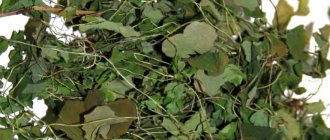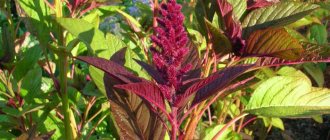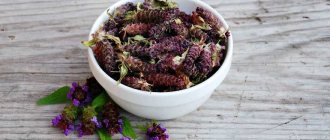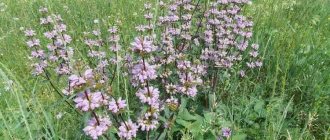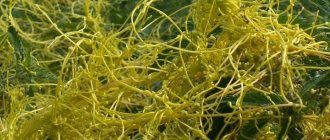What it looks like and where it grows
Euonymus is a plant of the Euonymus family, which is a low tree or shrub. The shoots of the crop are tetrahedral or rounded, smooth leaves are arranged in opposite order. The height of the plant can reach from 2 to 10 m, depending on the type; there are also creeping varieties that are used for decorating arches and fences. The popular name for euonymus is night blindness; it can also be found under the name sourweed, bruchmel or wolf's earrings.
The plant blooms with small, inconspicuous buds with a pale brownish or greenish color, collected in compact brushes or shields. The main decorative value of the euonymus comes from its leaves - dark green in spring and summer and red, orange, carmine and yellow in autumn. Only at the beginning of winter does the crown of the bush acquire a calm shade and become uniformly red or brownish.
Euonymus blooms in May and June
The plant bears dry winged or spiny leathery capsules with dark, red or white seeds. During the ripening period, the fruits are pale green, but upon reaching full ripeness they acquire a scarlet, dark purple, yellow or crimson color.
Attention! Euonymus is represented by almost 200 species. Almost all of them have medicinal qualities, but are also poisonous.
The plant is widespread in temperate and subtropical climates of both hemispheres. It does not grow in very cold regions, but can sometimes be found in the tropics. Selects mainly broad-leaved and mixed undergrowth, loves semi-shaded places, but also develops in the sun.
Description of euonymus
Like many other amazing plants, euonymus came to us from East Asia. Today it, like the seeds of other trees and shrubs, is planted in parks and groves around the world. It is also found in the wild. In our country, these are the southern regions, the middle zone, and the Far East. Under favorable growing conditions, the height of the “shrub” can reach 4 m and have a crown with a diameter of more than 3 meters.
In garden plots, when using a plant in landscape design, it is usually pruned, giving the bush its original shape. The branched root system is very sensitive to mechanical stress. However, in order for the plant to feel good, the soil must be constantly loosened to ensure air access to the roots.
The leaves are small in size and dark green in color. At the end of May, small, inconspicuous yellowish or white-green flowers appear on the branches. After they fade, fruits are formed in their place: a four-part, leathery capsule, inside of which there is a fleshy aneurysm with seeds, very rarely white, much more often red-brown or red.
Immature boxes, painted in pale green shades, are almost invisible among the foliage. But in autumn the plant appears in all its glory. The leaves acquire a bright, purple color. The capsule fruits open and also change their color to red, crimson, yellow, pink, burgundy, and orange, depending on the variety. Then the leaves fall, and bright lanterns of fruit remain hanging on the branches, delighting passers-by with their beauty against the backdrop of white snow all winter.
Young shoots of a greenish or brown tint also add decorative properties to the euonymus. In cross-section they can be not only round, but also tetrahedral. Along the shoot there are thin gray ridges, sharp cork ribs or brown warts, as, for example, in the warty euonymus growing in Russian forests. In summer they are also not very noticeable. And in winter, during snowfall, snow is retained in them, which gives the bush a very original look.
Chemical composition
The medicinal properties and contraindications of euonymus are due to the rich composition of the plant. Shoots, leaves, roots and seeds contain:
- carbohydrates and steroids;
- alkaloids;
- asparagine;
- evonymic acid;
- glucose and rhamnose;
- cyclitols;
- carotenoids;
- triterpenoids;
- linoleic and linolenic acids;
- triacetin;
- flavonoids;
- evolin;
- caffeine;
- ascorbic acid;
- arpepavine and theophylline;
- glycosides.
If used carelessly, the plant can cause severe poisoning. For medicinal purposes, it is used strictly according to proven recipes in small dosages.
Why is euonymus useful?
Poisonous euonymus, when used carefully, can improve the condition of the body. In particular, a medicinal plant:
- has diuretic properties and helps eliminate edema;
- calms the nervous system and evens out the emotional background;
- relieves headaches and helps cope with severe migraines;
- has a laxative effect and improves peristalsis for constipation;
- strengthens blood vessels and supports normal heart function;
- helps thin mucus in dry coughs;
- fights fungal infections of the skin and nails;
- helps with malaria;
- cleanses the liver and prevents the development of inflammation.
Euonymus is used to get rid of parasites. Decoctions and infusions of the plant can be taken internally for worms or used to treat the skin for scabies and scabies.
Methods of preparation and use
Traditional medicine prepares alcoholic and aqueous medicines based on euonymus. In both forms, the plant is suitable for external and internal use, although in the latter case contraindications must be carefully studied.
Infusion
For sluggish blood circulation and reproductive problems, you can prepare an infusion of euonymus fruits.
They do it like this:
- Fresh or dried bolls of the plant are crushed in the amount of 1/2 small spoon.
- Pour 500 ml of boiling water into a thermos.
- Leave to infuse, covered, for two hours.
We recommend reading: Thermopsis: composition, instructions for using the infusion, recipes
The finished product must be strained to remove the sediment. Take an infusion of only 15 ml three times a day, treatment is continued for up to two weeks. After this, be sure to take a break of at least 25 days.
An infusion of euonymus fruit relieves skin inflammation and helps with bleeding gums.
Tincture
For surges in blood pressure and frequent headaches, euonymus tincture is recommended. It is done according to the following algorithm:
- Grind 10 g of plant bark.
- Pour 100 ml of alcohol into a glass container.
- Leave to infuse for two weeks in a dark place.
- When ready, strain.
You need to take the tincture 5-6 drops three times a day. To prevent the product from burning the mucous membranes, first dilute it in a small amount of water.
You can drink euonymus tincture for hypertension for up to two weeks, followed by a break of 45 days.
Decoction
A useful decoction of euonymus is used for cardiovascular diseases. The recipe for the drink looks like this:
- The dry bark of the plant is ground into powder in an amount of 5 g.
- Pour the raw material with 500 ml of hot water.
- Boil the euonymus over low heat for five minutes.
- Leave covered until cool.
Take the strained product 15 ml on an empty stomach three times a day. Therapy is continued for two weeks.
Euonymus decoction is suitable for treating inflamed wounds and cuts
Use in folk medicine
First of all, euonymus has found wide application in industrial production. Its wood is used in the construction of various structures, the manufacture of musical instruments, as well as small household items. The tree is also used in engraving, pencils and leads. Gutta-perch, made from euonymus raw materials, was widely used in surgery and for filling teeth in dentistry in the 20th century.
Also, leaves and fruits are used in the production of natural dyes of yellow, brown and green tones. The seed pod is used in the preparation of cosmetics, and the oil from the fruit is a component for making soap. This tree reduces the number of various viruses that are in the air and releases phytoncides that can prevent migraines and arterial hypertension.
In veterinary medicine, the fruits are used to prepare remedies for skin diseases in animals. All aerial parts of the plant are also widely used in homeopathy and traditional medicine to treat the following diseases:
- nervous disorders;
- headache;
- malaria;
- scabies;
- pediculosis;
- helminthiasis;
- vascular and heart diseases;
- acne;
- ulcers;
- rashes;
- fungal diseases;
- cholecystitis;
- hepatitis.
Here are a number of recipes that you can use to prepare medicines.
Infusions
- It is recommended to use for impotence and loss of sexual desire. 0.5 tsp. Pour boiling water (500 ml) over crushed fresh or dried fruit boxes and leave for 2 hours. Then filter and take 15 ml three times between meals for 14 days. Take a break for 25 days and resume the course of treatment. You can also normalize potency if you regularly drink birch sap.
- This infusion is used externally for fungal infections of the nails and skin. 50 g of fresh branches must be chopped and poured with boiling water (200 ml). Let sit covered until completely cool. Apply to affected areas 5-6 times a day.
Decoctions
- This medicine helps with cardiovascular diseases. 1 tsp. add crushed bark to water (500 ml) and boil for 5 minutes, let it brew until it cools. For constipation, you need to drink 15 ml on an empty stomach in the morning. For cardiovascular diseases, drink 15 ml three times before meals for 15 days, then take a break for 45 days and resume taking it.
- This decoction is used for dry coughs, as well as for inflammatory liver diseases. 1 tbsp. l. Add water (500 ml) to the fruit and boil for 10 minutes over very low heat. Leave with the lid closed until it cools completely, then filter. Drink 15 ml an hour after meals three times a day. Immortelle helps with many liver diseases.
Tincture
This medicine helps normalize blood pressure and is a good means of preventing heart attacks and strokes. Pour 10 g of bark with alcohol (100 ml), leave for 15 days. Drink 5-6 drops three times for two weeks; after 45 days, you can repeat the course of treatment. You can drink hawthorn tea for hypertension.
Use of euonymus in medicine
The beneficial properties of euonymus are manifested when preparing the woody parts, leaves and fruits of the plant. Traditional medicine offers several proven recipes for using the culture for diseases.
For dry cough
Euonymus has expectorant properties and removes mucus from the respiratory tract. For dry cough and bronchitis, it is recommended to prepare the following decoction:
- Dry euonymus fruits in the amount of a large spoon are poured into 500 ml of water.
- Place on low heat and boil for about ten minutes.
- Remove from the stove and keep covered until cool.
The strained infusion is consumed on a full stomach three times a day, 15 ml. For a sore throat, it is better to pre-heat the drug before use.
For nail fungus
Euonymus has fungicidal properties and helps to quickly cope with fungal infections of the skin and nail plates. Use the following infusion:
- Pour 200 ml of boiling water over about 50 g of chopped plant branches.
- Cover the vessel with a lid and leave until cool.
- Strain from the sediment.
In the prepared euonymus product, moisten a clean cloth and apply to the affected area for half an hour. Procedures are allowed to be carried out up to six times a day.
For swelling
The diuretic properties of euonymus are beneficial for fluid retention in the body and poor kidney function. The medicinal decoction is made according to the following algorithm:
- Measure out a large spoonful of crushed dry euonymus leaves.
- Pour in 250 ml of hot liquid.
- Heat over low heat for four minutes.
- Leave covered for about two hours.
The finished product is passed through gauze. It is necessary to take the infusion of the plant up to three times a day, 15 ml in between meals.
Warning! Euonymus is used with caution for kidney stones. If the stones are large, the diuretic infusion can provoke their movement and cause pain.
For migraines
Euonymus shoots have a vasodilator and analgesic effect. For migraines, the following remedy is recommended for use:
- Pour 500 ml of boiling water into a large spoon of chopped branches.
- Heat on the stove over low heat for five minutes.
- Cool covered for two hours and strain.
You need to drink the decoction three times a day, 15 ml. The maximum duration of treatment is two weeks.
A decoction of euonymus for headaches has an additional calming and relaxing effect.
For scabies
The beneficial euonymus has an inhibitory effect on skin parasites. In the treatment of scabies, the following infusion can be used externally:
- Dry leaves and bark are mixed in equal quantities and crushed.
- Measure out five large spoons of medicinal raw materials and pour 1 liter of boiling water.
- Leave the product covered until it cools.
- Pass the solution through cheesecloth to filter out any sediment.
We recommend reading: Mullein grass: medicinal properties and contraindications, photos
The prepared preparation is used to wipe the skin and apply compresses and lotions. The product can also be used for lice; in this case, rinse your hair with warm infusion.
For hypertension
The medicinal euonymus equalizes blood pressure and helps with hypertension in the initial stages. For therapeutic purposes, prepare a strong tincture:
- Measure out 100 g of dry plant bark and grind it properly by hand or with a blender.
- Pour the powder into 1 liter of medical alcohol 70%.
- Shake the closed container and put it in a darkened cupboard for two weeks.
- After the period has passed, filter.
You need to take the plant tincture 8 drops three times a day with a small amount of clean water.
Taking euonymus for hypertension continues until you feel better, but no more than two weeks
Warning! In severe forms of hypertension, euonymus may not be effective. It is advisable to discuss the use of the tincture with your doctor.
For impotence
The tonic properties of euonymus accelerate blood flow in the pelvic organs and improve reproductive functions in men. To restore potency, the following drug is prepared:
- Measure out 1/2 small spoon of dried fruit.
- Pour 500 ml of hot liquid into the raw material.
- Leave in a thermos or covered for two hours.
- Filter through folded gauze to remove sediment.
The drug should be taken three times a day, using a large spoon on an empty stomach. In total, treatment with the euonymus plant is continued for no more than three weeks.
For constipation
Euonymus wood has mild laxative properties and helps relieve constipation. To stimulate intestinal peristalsis, prepare the following decoction:
- Grind the plant bark into powder and measure out 5 g.
- Brew medicinal raw materials with 500 ml of hot liquid.
- Cook over low heat on the stove for five minutes.
- After an hour of infusion under the lid, filter.
You need to take the drink once a day, half a glass on an empty stomach. It is better to limit yourself to 1-2 days of using the drug - it is not intended for long-term use.
Euonymus. Useful properties of euonymus
Euonymus energy. Medicinal and beneficial properties of euonymus.
Japanese euonymus is grown at home. It is a shrub with a well-developed root system. The leathery, smooth leaves of euonymus are mostly green, but can also be variegated. The shape of the leaves is oblong-oval. Species with a variety of leaf sizes and colors have been developed. Most gardeners prefer variegated varieties, which have white and yellow spots on the dark green leaves and a border along the edges of the leaves. Euonymus blooms in June; the flowers are small, white, greenish-white or light yellow. The plant has very beautiful fruit boxes of dark pink or red color. However, most types of indoor euonymus do not bloom at home.
Euonymus is a subtropical plant that is quite unpretentious to growing conditions. It is perfect for decorating a garden or balcony in the summer. It can be planted on both the sunny and shady sides, however, variegated forms are recommended to be planted on the sunny side, otherwise the leaves may turn green. Heat has a bad effect on the plant; it is advisable to place it in a cool room where the air temperature does not exceed 25 °C. In winter, it is better to keep the euonymus at a temperature of at least 12 ° C, since its leaves will begin to fall off from the cold.
Euonymus can reduce the number of microbes in the air by 50%; the beneficial components it contains relieve migraines and prevent the development of arterial hypertension.
Euonymus infusion for liver diseases
Ingredients: 1.5 tbsp. l. euonymus leaves (crushed), 500 ml of water.
Method of preparation : pour boiling water over euonymus leaves and boil in a water bath for 5 minutes. Leave for 1 hour and strain.
Directions for use: take 5 tbsp infusion. l. 3 times a day after meals.
Euonymus tonic
Ingredients : 2 tbsp. l. dry euonymus leaves, 500 ml of water.
Method of preparation : pour the raw material with water and boil for 15-20 minutes. Cool and strain.
Directions for use : take 1 tsp decoction. 3 times a day. The course of treatment lasts 2-3 days.
Euonymus decoction for fungal nail diseases
Ingredients: 1 tbsp. l. euonymus leaves, 100 ml of water.
Method of preparation : pour boiling water over the leaves and leave for 30 minutes. Cool and strain.
Directions for use: treat the skin around the edges of the nails and the nails themselves.
Note: if you have a fungal infection of your feet, you can wrap your toes with a bandage soaked in the broth at night and put on socks.
We recommend watching:
Euonymus. Growing at home
Contraindications
The benefits and harms of euonymus are closely related to each other. The medicinal plant should not be used if:
- individual allergies;
- during pregnancy;
- for hemorrhoidal bleeding;
- during lactation;
- with inflammation of the small intestine;
- during exacerbation of ulcers and pancreatitis.
The plant is not offered to children under 12 years of age to avoid negative reactions. During the treatment process, even adults must follow the dosages indicated in the recipes. With prolonged use or exceeding safe volumes, euonymus leads to the development of nausea, vomiting and diarrhea, and also causes depression of cardiac activity.
Collection and preparation
Euonymus can be harvested for medicinal purposes throughout the year. The leaves of the plant are collected during the period of fruit ripening. At this time, the plates are less poisonous, although the healing properties are not so pronounced. The roots and the seed pods themselves are harvested in the fall shortly before the cold weather.
The collected euonymus raw material must be sorted and cleaned of contaminants. To dry, the plant is laid out in a ventilated room or outside under a canopy if the weather is dry and warm. After the moisture has evaporated, the workpieces are crushed for convenience and packaged in glass jars or paper bags. Euonymus should be stored away from sunlight in a dry and cool place.
You can use the bark and roots of the euonymus for about three years, and the leaves are collected again annually.
Using euonymus in landscape design
Euonymus is a picturesque plant that can transform any park or garden. It is unpretentious and attractive throughout the warm season. And with the onset of autumn, when other plants take on dull tones, the decorativeness of the euonymus only increases. The plant is appreciated by landscape designers and is actively used to decorate public gardens, parks and alleys, creating hedges. However, summer residents do not appreciate the design characteristics of the euonymus and they are in no hurry to plant it in their garden plots. To change their minds, they should familiarize themselves and learn everything about euonymus.
The plant is extremely unpretentious, has good winter hardiness and grows well in any region of the Russian Federation, and an euonymus planted in a summer cottage will delight you with its stunning decorative effect.
Thanks to its decorative properties, euonymus can decorate any garden or personal plot
Growing euonymus
It is better to plant euonymus in the spring; planting is also possible in the fall. Choose a sunny area, without nearby groundwater. The soil needs to be fertile with a slightly alkaline or neutral reaction. That is why drainage is placed at the bottom of a 60x60 hole, after which it is filled with a mixture of humus and fertile soil. If the soil is acidic, add two cups of lime additionally. The seedling is planted, the soil around it is compacted, abundant watering is carried out and the tree trunk circle is sprinkled with mulch. Care includes timely watering and fertilizing 3 times per season.
Euonymus requires pruning; it is given an elliptical, conical or spherical shape. It is better to hold this event in spring or late autumn.


